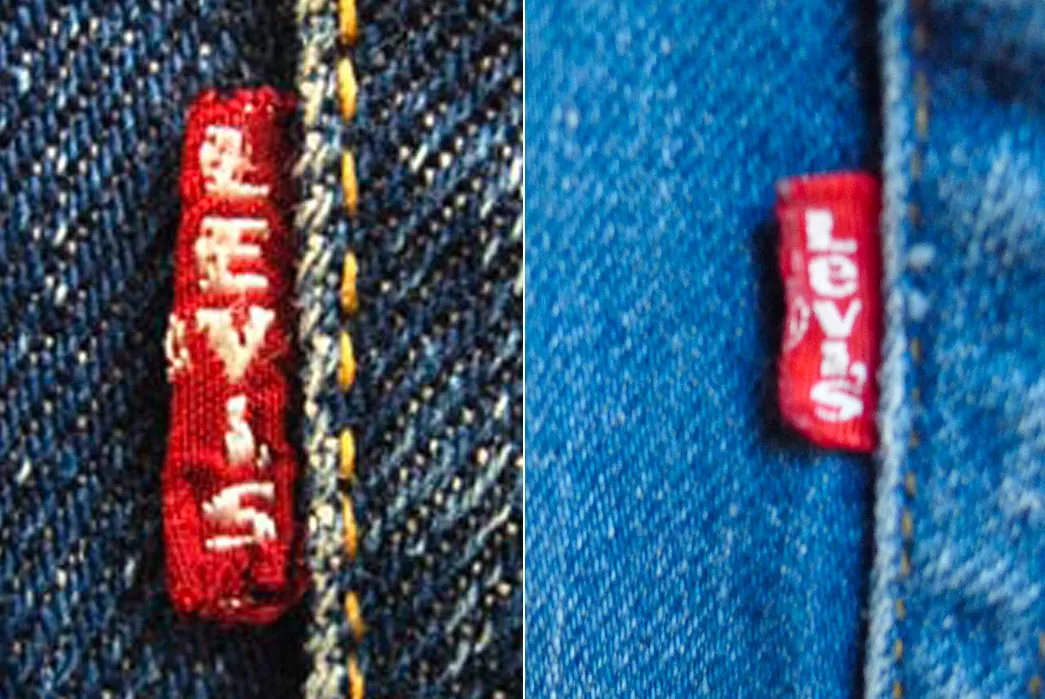Check the red tab. In 1936, Levi Strauss & Co.'s National Sales Manager, Chris Lucier came up with the idea of placing a folded red cloth ribbon in the seam of a rear patch pocket. This was a marketing ploy to help folks distinguish Levi Jeans from the hundreds of other brands who where attempting to establish themselves. This was soon copyrighted, and now, only jeans made by Levi Strauss & Co can legally have a Tab on the rear pocket. Thought out the years there have been countless different adaptations of the Tab, including varying colors, lettering, and sizing. This is how you can use the tab to authentic and Date Your Levi's Jeans.
- The first thing you want to look at is if there is a tab at all. If you happen to have an authentic pair of Levi jeans with no tab, they are worth a fortune! This However is very very rare. Most of the time authentic Levi's without a tab are only that way because a previous owner cut it off. Also, a 1920's Pair of Levi's will have a great deal of wear and tear, making it pretty easy to distinguish
 A $45,000 pair of 1920's Levi's With no red tab.
A $45,000 pair of 1920's Levi's With no red tab.
- Secondly, does it say LEVI's or Levi's? This is called the "big e". before the year 1971 all Levi jeans had a tab spelled with all capital letters. We focus on the E simply because it is the only letter in the name Levi whose shape changes when capitalized. in 2018 Levi's brought back the capital E, it is very easy to distinguish, since true vintage pre-1971 Levi's will not have a care tag, while newer ones will

- Does your red tab have nothing on it? Don't worry, that doesn't mean they are fake. starting in the late 80's, 10% of all Levi's jeans only have the trademark symbol on them, in order for Levi's to preserve the use of the trademark. Ironically, bootleggers are much more likely to try and print the lettering than use a blank tab! If you see a blank tab, that means late 80's or newer.

- Different Color Tabs. According to Tracey Panek, a Levi's Historian "The Tab Device color itself would eventually move beyond red to white, orange, black, silver and more. These represented different lines of clothing, like the blue Tab with white lettering for our 1950s Denim Family; the black Tab with gold lettering for our 1960s Sta-Prest; or the silver tab with white lettering for our 1990s SilverTab line. The garments ranged from corduroy flares and boot cut jeans to loose-fit Levi’s®." However it is very difficult to solely use tab color to date. Many different Levi's colored tags where discontinued and brought back over the years (even a carrot tab that was a part of their "fresh produce" line), but generally a colored tag is more likely to be vintage. Silvertabs where made well into the 2000's, but many are made in the 90's. Orange Tabs usually range from the Mid 70's to Early 90's. The other colors I unfortunately don't have enough experience with to suggest a specific time period, but they are usually 90's or older, especially if made in USA.



When it comes to Levi Strauss & Co.'s iconic red tab, there always more to learn. Whether the colors or the letter change, each small detail can give you insight of the authenticity and age of the garment the tabs lives on. Stay tuned for my next blog, diving deep into the art of the Levi Care Label.

